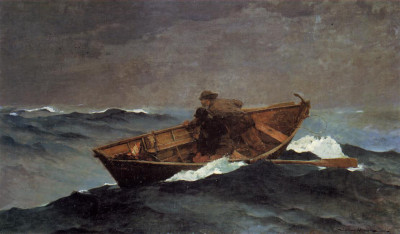 Buy Art Prints Now
Buy Art Prints Nowfrom Amazon
* As an Amazon Associate, and partner with Google Adsense and Ezoic, I earn from qualifying purchases.
Lost on the Grand Banks is a 1885 painting by Winslow Homer. It was purchased by Bill Gates in 1998 for a reported $30 million, making it one of the most valuable paintings by this artist.
This simple composition perfectly captures the way in which most people think about Winslow Homer. We are at sea, in stormy conditions, and in front of us we find humanity struggling to deal with the ferocity of nature. A sailor is desperately clinging on to his boat as he gets thrown around in the waves. His small, simple wooden boat looks feeble in comparison to the seemingly endless pattern of waves which continue to rise up against it. There is none of the tranquility that we find in other Homer paintings, but instead we witness the reality for sailors all around the world. Homer would take this theme further and actually depict shipwrecks in the latter part of his career, often with bodies strewn across the shoreline after a particularly rough night at sea. The artwork is listed as being 130cm in width, and around 81cm in height and was entirely produced using oils. It is likely that Homer would have completed some drawn sketches prior to beginning this piece on canvas, based on his normal working practices.
Homer spent much of his later period focusing on seascapes such as this, with some of his best examples besides Lost on the Grand Banks being the likes of Breezing Up (A Fair Wind), The Herring Net, The Fog Warning and The Life Line. He set up a studio close to the sea at one point in his life in order to be able to access this environment as easily as possible. He would also travel to the Caribbean several times and enjoyed the slightly different conditions that he found there. The mood within this interpretation was dark, and that is matched by the colour tones - the sky is dark and drab, without any visible features. The artist allows a thick tone of dark grey to spread right across the sky. He often marvelled at how quickly conditions could change at sea, and then back again within just a few minutes. Also within Lost on the Grand Banks there are no single, crashing waves, but rather an endless open expanse of rocky seas which deliver an ongoing battle to the sailor which by contrast might last for hours, even days at sea.
Homer was an important artist within the progress of the US, bringing local scenes to the public when previously most has simply followed the methods of Europeans. He was certainly influenced by European and also Asian art, but he chose to incorporate this in a subtle manner, making sure American life was his true focus. This brought him favour with the public and collectors alike, who perhaps had been calling out for artists to work in this manner for some time. Although his career was not always profitable, he realised that the style that he used was welcome within the US and over time his reputation has established itself on an international scale. Exhbitions of his work can now be found right across the world, and he remains one of the most famous American painters of all time, best known for his seascapes such as this one.



